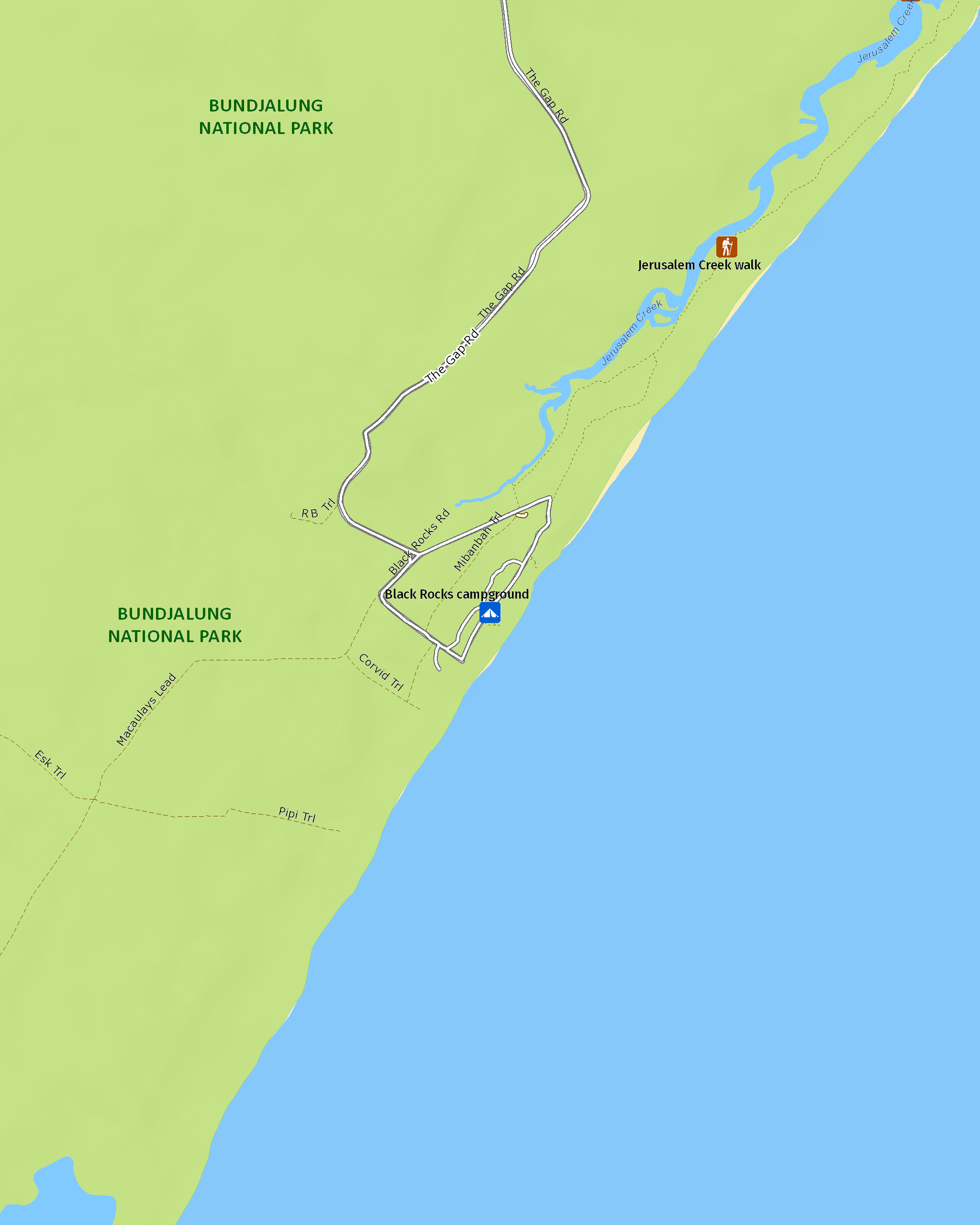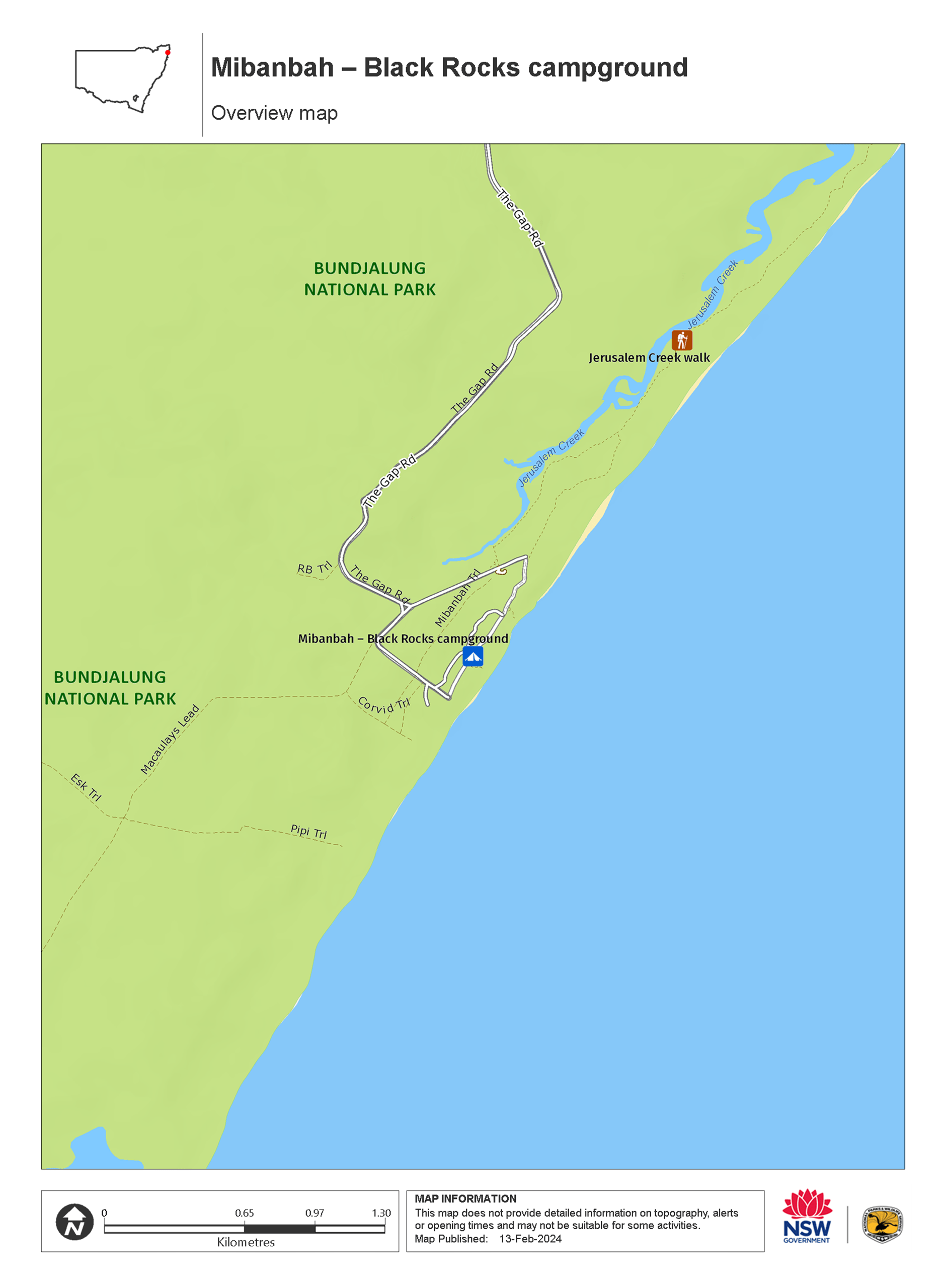Mibanbah – Black Rocks campground
Bundjalung National Park
Overview
Mibanbah - Black Rocks campground, near Yamba, is positioned perfectly by Ten Mile Beach and Jerusalem Creek. Enjoy kayaking, fishing, swimming, or simply relax in the tranquil waterfront setting.
| Number of campsites | 51 |
|---|---|
| Camping type | Tent, Camper trailer site, Caravan site, Camping beside my vehicle |
| Facilities | Picnic tables, carpark, toilets |
| What to bring | Drinking water, firewood |
| Entry fees |
Park entry fees are not included in your camping fees. |
| Group bookings | Book up to 20 people or 5 sites online. For larger groups, make a group booking enquiry. |
| Please note |
|
Set behind the dunes amongst tuckeroo and banksia trees, Mibanbah – Black Rocks campground is perfectly positioned right by Ten Mile Beach and near Jerusalem Creek. Not far from Evans Head, it is a great place for a family camping holiday, with campsites for caravans, camper trailers and motorhomes.
Getting to the beach is easy along the short walking track that leads you north along creek banks and through wetlands to the mouth of the ocean. Jerusalem Creek paddle route offers excellent opportunities for paddling—you can launch your canoe or kayak from the pontoon and camp the night at Jerusalem Creek or return to the main campground. Go at dawn or dusk to increase your chances of spotting animals and birds.
In the evening, enjoy a tasty dinner at one of the picnic tables located throughout the campground.
Map

Map legend

Map

Local alerts
For the latest updates on fires, closures and other alerts in this area, see https://www.nationalparks.nsw.gov.au/camping-and-accommodation/campgrounds/mibanbah-black-rocks-campground/local-alerts
Bookings
- National Parks Contact Centre
- 7am to 7pm daily
- 1300 072 757 (13000 PARKS) for the cost of a local call within Australia excluding mobiles
- parks.info@environment.nsw.gov.au
Operated by
- Alstonville office
- Monday to Friday, 8:30am to 4:30pm
- 02 6627 0200
- npws.richmondriver@environment.nsw.gov.au
- Russelton Industrial Estate, 7 Northcott Crescent, Alstonville NSW 2477
Park info
- in Bundjalung National Park in the North Coast region
Bundjalung National Park is always open but may have to close at times due to poor weather or fire danger.
-
Park entry fees:
$8 per vehicle per day.
Buy annual pass.
Visitor info
All the practical information you need to know about Mibanbah – Black Rocks campground.
Getting there and parking
Mibanbah – Black Rocks campground is in the Black Rocks precinct of Bundjalung National Park. To get there:
- Access to the campground is via the Tuckombil Road exit from the Pacific Highway near the town of Woodburn.
- Take the Tuckombil Road turnoff. Follow Tuckombil Road for 2.2km south to The Gap Road.
- Turn left onto The Gap Road.
- The campground is 20km south along The Gap Road.
Please drive slowly along The Gap Road because it's unsealed. Follow the speed limit around the campground for the safety of other campers. Take care on speed bumps, especially if you have a vehicle with low clearance.
Road quality
- Unsealed roads
Vehicle access
- 2WD vehicles
Weather restrictions
- All weather
Parking
Parking is available on your campsite for tent or vehicle-based campsites.
- Tent only sites (except for the 2 remote sites): Parking is available in the gravel carpark about 30 to 50m from campsites.
- Group sites: Parking is available next to your group campsite.
- Jerusalem Creek sites: This is a remote camping area, campers must park their vehicles in the main gravel Black Rocks campground (4km walk).
Best times to visit
There are lots of great things waiting for you in Bundjalung National Park. Here are some of the highlights.
Spring
Head to Iluka Bluff for a spectacular coastal view of the park, beaches and the mouth of the river – keep your eyes peeled for whales on their return migration.
Winter
Escape to the wintersun for a family camping holiday, it should still be warm enough for a swim so remember to bring your cozzie.
Weather, temperature and rainfall
Summer temperature
Average
20°C and 26°C
Highest recorded
42.5°C
Winter temperature
Average
12°C and 21°C
Lowest recorded
2.7°C
Rainfall
Wettest month
Between January and March
Driest month
Between August and October
Facilities
- Campsites are marked and suitable for motorhomes, caravans, camper trailers, campervans and tents. Sites are unpowered.
- There are 3 exclusive group camp areas: Black Rocks, Booroora and Yabra.
- There are 2 remote tent-only campsites in Jerusalem Creek, located 4km from the main campground. The sites are accessible by taking the Jerusalem Creek walk, or by paddling downstream along Jerusalem Creek (non-powered craft or silent electric motors only).
- Canoe launching pontoon
- Dump Ezy for caravans
- Clothes line
- Power, showers, water and rubbish bins are not available.
- There are no barbecue facilities. There are only fire rings on each individual campsite. You need to bring your own firewood.
Toilets
There are four dual-stall accessible non-flush toilet blocks at the campground. They're located in the north, mid and south sections of the campground.
- Non-flush toilets
Picnic tables
Carpark
Step-free access
The campground is flat and step-free.
There's a hard-packed gravel pathway that leads to the Jerusalem Creek area. To get to other parts of the campground, you'll need to cross over flat grass.
There are 2 pathways to access the beach, but both are soft-sand with steep descents.
Maps and downloads
Accessibility
Disability access level - medium
Mibanbah – Black Rocks campground is flat and step-free, with the following accessible facilities:
- There's a hard-packed gravel pathway from the main campground to the Jerusalem Creek area
- There are accessible toilets in the north, mid and south sections of the campground. You can reach the toilets either along a hard-packed gravel pathway or elevated timber walkways.
There are some parts of the campground where people with reduced mobility may need assistance:
- Aside from the pathway to the Jerusalem Creek area, there are no other paths. You'll need to cross over flat grass and hard-packed ground to reach the facilities.
- The paths to the beach are soft-sand and have steep descents.
Permitted
Fishing
A current NSW recreational fishing licence is required when fishing in all waters.
Spear fishing is not permitted and spearguns may not be brought into the campground
Prohibited
- Amplified music is not permitted.
- Glass is prohibited in watercrafts or campsites at the Jerusalem Creek sites.
Gathering firewood
Pets
Pets and domestic animals (other than certified assistance animals) are not permitted. Find out which regional parks allow dog walking and see the pets in parks policy for more information.
Smoking
NSW national parks are no smoking areas.
Learn more
Mibanbah – Black Rocks campground is in Bundjalung National Park. Here are just some of the reasons why this park is special:
An ancient landscape

At Bundjalung National Park you can visit Gummigurrah, an area that was used as a winter camping ground by the Bandjalung People. This park is one of a group where the Bandjalang People's native title rights have been recognised and is only the third determination of native title rights in New South Wales. Native title rights come from the Bandjalang People's traditional laws and customs and legally recognise the Bandjalang People's connection to Country. This means that these lands will continue to be places of ceremony, learning and inspiration for generations to come.
Meet the locals

The varied habitat of Bundjalung National Park is home to over 140 species of fauna. Wake to the morning melodies of eastern whip-birds, bower birds and the rare barred cuckoo-shrike. At dawn and dusk, you might find eastern grey kangaroos, red-necked wallabies and swamp wallabies congregating around your campsites. Scour the tops of nearby trees and you might also catch a glimpse of a sleeping koala or two.
- Iluka Bluff lookout Stay as long as you like to enjoy the views at Iluka Bluff lookout, near Yamba. Not only is it an excellent whale watching spot, it’s also a great place to picnic.
- Jerusalem Creek walk Keep your eyes peeled for birds nesting along the creek along the Jerusalem Creek walk. Enjoy the hike as a day walk or shorter walk and finish up with a picnic lunch.
Water world

Bundjalung protects a variety of environments that feature water, including beaches, rivers, wetlands and lagoons. You'll find different types of plants, animals and birds in each one; look for coast banksia, coast she-oak and coastal wattle on the dunes that back onto the beach. Immerse yourself in this world by canoeing the waterways, rambling in the rock pools and swimming in the ocean.
Plants and animals protected in this park
Animals
-

White-bellied sea eagle (Haliaeetus leucogaster)
White-bellied sea eagles can be easily identified by their white tail and dark grey wings. These raptors are often spotted cruising the coastal breezes throughout Australia, and make for some scenic bird watching. Powerful Australian birds of prey, they are known to mate for life, and return each year to the same nest to breed.
-

Eastern ground parrot (Pezoporus wallicus wallicus)
The eastern ground parrot is a beautiful, ground-dwelling native bird that lives in low heathland habitat along the NSW North and South coasts and escarpments. It’s listed as a vulnerable species in NSW.
-

Peron's tree frog (Litoria peroni)
Peron’s tree frog is found right across NSW. These tree-climbing and ground-dwelling Australian animals can quickly change colour, ranging from pale green-grey by day, to a reddish brown with emerald green flecks at night. The male frog has a drill-like call, which has been described as a 'maniacal cackle’.
-

Emu (Dromaius novaehollandiae)
The largest of Australian birds, the emu stands up to 2m high and is the second largest bird in the world, after the ostrich. Emus live in pairs or family groups. The male emu incubates and rears the young, which will stay with the adult emus for up to 2 years.
-

Koala (Phascolarctos cinereus)
One of the most renowned Australian animals, the tree-dwelling marsupial koala can be found in gum tree forests and woodlands across eastern NSW, Victoria and Queensland, as well as in isolated regions in South Australia. With a vice-like grip, this perhaps most iconic but endangered Australian animal lives in tall eucalypts within a home range of several hectares.
-

Lace monitor (Varanus varius)
One of Australia’s largest lizards, the carnivorous tree-dwelling lace monitor, or tree goanna, can grow to 2m in length and is found in forests and coastal tablelands across eastern Australia. These Australian animals are typically dark blue in colour with whitish spots or blotches.
-

Grey-headed flying-fox (Pteropus poliocephalus)
The grey-headed flying fox is Australia's largest native bat, with a wingspan up to 1m. This threatened species travels up and down south-eastern Australia and plays a vital role in pollinating plants and spreading seeds in our native forests.
-

Australian pelican (Pelecanus conspicillatus)
The curious pelican is Australia’s largest flying bird and has the longest bill of any bird in the world. These Australian birds are found throughout Australian waterways and the pelican uses its throat pouch to trawl for fish. Pelicans breed all year round, congregating in large colonies on secluded beaches and islands.

